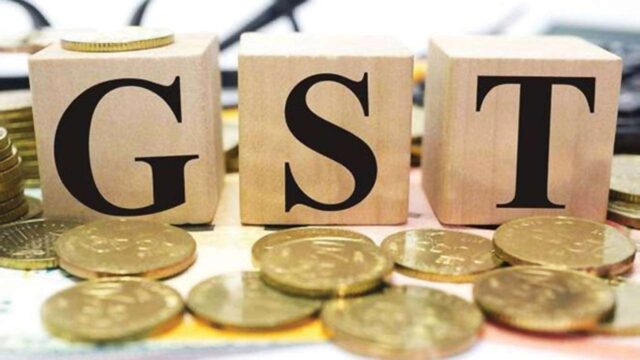Amit Pranlal Suru, MD of M/S. Teamworks Associates (P) Ltd- {LOAN SOLUTION} have discussed about Housing and Mortgage Finance sector in India In earlier article.
Now in today’s article he is going to discuss on current HOT topic which is shacking to the nation currently.
What is GST (Goods and Services Tax)?
It is a destination based tax on consumption of goods and services. It is proposed to be levied at all stages right from manufacture up to final consumption with credit of taxes paid at previous stages available as setoff. In a nutshell, only value addition will be taxed and burden of tax is to be borne by the final consumer.
GST – CONCEPT
The introduction of Goods and Services Tax (GST) would be a very significant
step in the field of indirect tax reforms in India. By amalgamating a large number of Central and State taxes into a single tax, it would mitigate cascading or double taxation in a major way and pave the way for a common national market. From the consumer point of view, the biggest advantage would be in terms of a reduction in the overall tax burden on goods, which is currently estimated to be around 25%-30%. Introduction of GST would also make Indian products competitive in the domestic and international markets. Studies show that this would have a boosting impact on economic growth. Last but not the least, this tax, because of its transparent and self-policing character, would be easier to administer.
The salient features of GST:
(i) GST would be applicable on “supply” of goods or services as against the present concept of tax on the manufacture of goods or on sale of goods or on provision of services.
(ii) GST would be based on the principle of destination based consumption
taxation as against the present principle of origin based taxation.
(iii) It would be a dual GST with the Centre and the States simultaneously levying it on a common base. The GST to be levied by the Centre would be called Central GST (CGST) and that to be levied by the States would be called State GST (SGST).
(iv) An Integrated GST (IGST) would be levied on inter-State supply (including
stock transfers) of goods or services. This would be collected by the Centre so
that the credit chain is not disrupted.
(v) Import of goods or services would be treated as inter-State supplies and would be subject to IGST in addition to the applicable customs duties.
(vi) CGST, SGST & IGST would be levied at rates to be mutually agreed upon by the Centre and the States under the aegis of the GST Council (GSTC).
GST would replace the following taxes:
GST would replace the following taxes currently levied and collected by the Centre:
- a) Central Excise duty
- b) Duties of Excise (Medicinal and Toilet Preparations)
- c) Additional Duties of Excise (Goods of Special Importance)
- d) Additional Duties of Excise (Textiles and Textile Products)
- e) Additional Duties of Customs (commonly known as CVD)
- f) Special Additional Duty of Customs (SAD)
- g) Service Tax
- h) Cesses and surcharges insofar as far as they relate to supply of goods or
services
State taxes that would be subsumed within the GST are:
- a) State VAT
- b) Central Sales Tax
- c) Purchase Tax
- d) Luxury Tax
- e) Entry Tax (All forms)
- f) Entertainment Tax (except those levied by the local bodies)
- g) Taxes on advertisements
- h) Taxes on lotteries, betting and gambling
- i) State cesses and surcharges in so far as they relate to supply of
goods or services.
(ix) GST would apply to all goods and services except Alcohol for human consumption.
(x) GST on five specified petroleum products (Crude, Petrol, Diesel, ATF &
Natural gas) would be applicable from a date to be recommended by the GSTC.
(xi) Tobacco and tobacco products would be subject to GST. In addition, the Centre would continue to levy Central Excise duty.
(xii) A common threshold exemption would apply to both CGST and SGST.
Taxpayers with an annual turnover of Rs. 20 Lakhs (Rs. 10 Lakhs for special
category States) would be exempt from GST. A compounding option (i.e. to
pay tax at a flat rate without credits) would be available to small taxpayers
(except manufacturers and service providers) having a annual turnover of up to
Rs 50 Lakhs. The threshold exemption and compounding scheme would be Optional.
(xiii) The list of exempted goods and services would be kept to a minimum and it would be harmonized for the Centre and the States as well as across States as far as possible.
(xiv) Exports would be zero-rated.
(xv) Credit of CGST paid on inputs may be used only for paying CGST on the
Output and the credit of SGST paid on inputs may be used only for paying
SGST. In other words, the two streams of input tax credit (ITC) cannot be cross utilized, except in specified circumstances of inter-State supplies for payment of IGST. The credit would be permitted to be utilized in the following manner:
- a) ITC of CGST allowed for payment of CGST & IGST in that order;
- b) ITC of SGST allowed for payment of SGST & IGST in that order;
- c) ITC of IGST allowed for payment of IGST, CGST & SGST in that
order.
ITC of CGST cannot be used for payment of SGST and vice versa.
(xvi) Accounts would be settled periodically between the Centre and the State to ensure that the credit of SGST used for payment of IGST is transferred by the originating State to the Centre. Similarly the IGST used for payment of SGST would be transferred by the Centre to the destination State. Further the SGST portion of IGST collected on B2C supplies would also be transferred by the Centre to the destination State. The transfer of funds would be carried out on the basis of information contained in the returns filed by the taxpayers.
(xvii) The laws, regulations and procedures for levy and collection of CGST and SGST would be harmonized to the extent possible.
WHY GST: PERCEIVED BENEFITS
- To Trade
- Reduction in multiplicity of taxes
- Mitigation of cascading / double taxation
- More efficient neutralization of taxes especially for exports
- Development of common national market
- Simpler tax regime
- Fewer rates and exemptions
- Distinction between Goods & Services no longer required
- To Consumers
- Simpler Tax system
- Reduction in prices of goods & services due to elimination of cascading
- Uniform prices throughout the country
- Transparency in taxation system
- Increase in employment opportunities
GST Rates :
GST is going to be applicable from 1st July 2017 so Recently GST Rates are Decided by GST Council on various Meetings, Recently GST Council Decide different GST Rates Slabs for India, Now GST Rates are finalized i.e GST Rates in India is 5%, 12%, 18% & 28%.
You can send us your inquiry / requirements for Loan..
E: homeloan.adv@gmail.com ; www.teamworkscapital.com; Tel: 022- 65 1111 05.
{LOAN SOLUTION}











